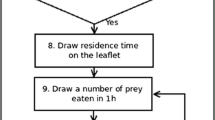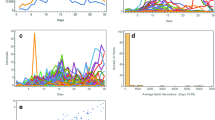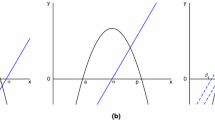Abstract
Observations on Mount St Helens indicate that the spread of recolonizing lupin plants has been slowed due to the presence of insect herbivores and it is possible that the spread of lupins could be reversed in the future by intense insect herbivory [Fagan, W. F. and J. Bishop (2000). Trophic interactions during primary sucession: herbivores slow a plant reinvasion at Mount St. Helens. Amer. Nat. 155, 238–251]. In this paper we investigate mechanisms by which herbivory can contain the spatial spread of recolonizing plants. Our approach is to analyse a series of predator-prey reaction-diffusion models and spatially coupled ordinary differential equation models to derive conditions under which predation pressure can slow, stall or reverse a spatial invasion of prey. We focus on models where prey disperse more slowly than predators. We comment on the types of functional response which give such solutions, and the circumstances under which the models are appropriate.
Similar content being viewed by others
References
Aronson, D. G. and H. F. Weinberger (1975). Nonlinear diffusion in population genetics, combustion, and nerve pulse propagation, in Lecture Notes in Mathematics, 446, J. A. Goldstein (Ed.), Berlin: Springer-Verlag, pp. 5–49.
Conway, E. D. (1984). Diffusion and (predator-prey) interaction: pattern in closed systems. Res. Notes Math. 101, 85–133.
Dunbar, S. R. (1986). Traveling waves in diffusive predator-prey equations: periodic orbits and point-to-periodic heteroclinic orbits. SIAM J. Appl. Math. 46, 1057–1078.
Fagan, W. F. and J. Bishop (2000). Trophic interactions during primary succession: Herbivores slow a plant reinvasion at Mount St. Helens. Amer. Nat. 155, 238–251.
Fife, P. C. (1976). Pattern formation in Reacting and Diffusing Systems. J. Chem. Phys. 64, 554–564.
Hadeler, K. P. and F. Rothe (1975). Travelling fronts in nonlinear diffusion equations. J. Math. Biol. 2, 251–263.
Hastings, A., S. Harrison and K. McCann (1997). Unexpected spatial patterns in an insect outbreak match a predator diffusion model. Proc. R. Soc. Lond. B 264, 1837–1840.
Hosono, Y. (1998). The minimal speed of traveling fronts for a diffusive Lotka Volterra competition model. Bull. Math. Biol. 60, 435–448.
Keener, J. P. (1987). Propagation failure in coupled systems of discrete excitable cells. SIAM J. Appl. Math. 47, 556–572.
Keener, J. P. (1993). The effects of discrete gap junction coupling on propagation in myocardium. J. Theor. Biol. 148, 49–82.
Keitt, T. H., M. A. Lewis and R. D. Holt (2000). Allee effects, invasion pinning and species borders. Submitted to Amer. Nat.
Lewis, M. A. and P. Kareiva (1993). Allee dynamics and the spread of invading organisms. Theor. Popul. Biol. 43, 141–158.
Lewis, M. A., B. Li and H. F. Weinberger (2000). Spreading speeds and the linear conjecture for two-species competition models. Submitted to J. Math. Biol.
May, R. (1974). Model Ecosystems, Princeton, NJ: Princeton University Press.
Murray, J. D. (1989). Mathematical Biology, Berlin: Springer Verlag.
Perko, L. (1991). Differential Equations and Dynamical Systems, New York: Springer Verlag.
Rothe, F. (1981). Convergence to pushed fronts. Rocky Mt. J. Math. 11, 617–633.
Sherratt, J. A., B. T. Eagan and M. A. Lewis (1997). Oscillations and chaos behind predator-prey invasion: mathematical artefact or ecological reality? Phil. Trans. R. Soc. Lond. B 352, 21–38.
Smoller, J. (1994). Shock Waves and Reaction-Diffusion Equations, New York: Springer Verlag.
Weinberger, H. F., M. A. Lewis and B. Li (2000). Analysis of the linear conjecture for spread in cooperative models. Submitted to J. Math. Biol.
Author information
Authors and Affiliations
Rights and permissions
About this article
Cite this article
Owen, M.R., Lewis, M.A. How predation can slow, stop or reverse a prey invasion. Bull. Math. Biol. 63, 655–684 (2001). https://doi.org/10.1006/bulm.2001.0239
Received:
Accepted:
Issue Date:
DOI: https://doi.org/10.1006/bulm.2001.0239




